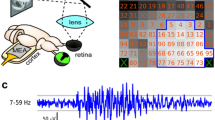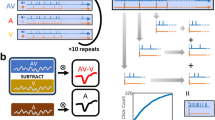Abstract
The origin and functional role of evoked potentials (EPs) of the tectum mesencephali (TM) were investigated in lower vertebrates, especially the frogRana temporaria L. EPs of TM were shown to reflect the synchronous appearance of postsynaptic potentials of the "first order." The fundamental characteristics of the EPs are determined by temporal dispersion of the afferent volley and localization of the afferent endings. The EPs play the role of a trigger for unit discharges, but the dynamics of intracentral excitatory activity is reflected only very slightly in EPs.
Similar content being viewed by others
Literature cited
Yu. I. Arshavskii, M. B. Berkinblit, S. A. Kovalev, V. V. Smolyaninov, and L. M. Chailakhyan, "Analysis of functional properties of dendrites in connection with their structure," in: Models of Structural and Functional Organization of some Biological Systems, Nauka, Moscow (1965), pp. 28–70.
Yu. B. Manteifel', "Analysis of reactive (evoked) potentials of the tectum mesencephali in frogs," Fiziol. Zh. SSSR,49, 790 (1963).
Yu. B. Manteifel', "Direct and transcommissural reactive potentials in the tectum mesencephali of frogs," Dokl. Akad. Nauk SSSR,148, 473 (1963).
Yu. B. Manteifel' and N. A. Lastochkina, "The direct cortical response of the tectum mesencephali in frogs and single unit responses," Zh. Évolyuts. Biokhim. i Fiziol.,5, 556 (1969).
G. D. Smirnov, "Functional organization of nerve centers," Vestn. Akad. Nauk SSSR, No. 1, 48 (1968).
G. D. Smirnov and Yu. B. Manteifel', "Comparative electrophysiological study of the brain in a series of vertebrate animals," Uspekhi Sovr. Biol.,54, No. 3, 309 (1962).
L. M. Chuppina, "Characteristics of cortical potentials formed on the basis of different ascending excitations," Fiziol. Zh. SSSR,53, 385 (1967).
F. Bremer, "Un aspect de la physiologie du corps calleux," Arch. Internat. Physiol.,61, 110 (1953).
P. Buser, "Analyse des réponses électriques du lobe optique à la stimulation de la voie visuelle chez quelques vertébrés inferieurs," Thes. Fac. Sci. Univ. Paris, Ser. A, No. 2703 (1955).
H. T. Chang, "Interaction of evoked cortical potentials," J. Neurophysiol.,16, 133 (1953).
B. Katz and S. Thesleff, "On the factors which determine the amplitude of the ‘miniature end-plate potential’," J. Physiol. (London),137, 267 (1957).
G. Lazar and G. Szekely, "Golgi studies on the optic center of the frog," Z. Hirnforsch.,9, 329 (1967).
Additional information
A. N. Severtsov Institute of Evolutionary Morphology and Ecology of Animals, Academy of Sciences of the USSR, Moscow. Translated from Neirofiziologiya, Vol. 2, No. 5, pp. 515–519, September–October, 1970.
Rights and permissions
About this article
Cite this article
Manteifel', Y.B. Evoked potentials of the visual center in lower vertebrates: Genesis and relation to unit activity. Neurophysiology 2, 388–391 (1970). https://doi.org/10.1007/BF01062804
Received:
Issue Date:
DOI: https://doi.org/10.1007/BF01062804




